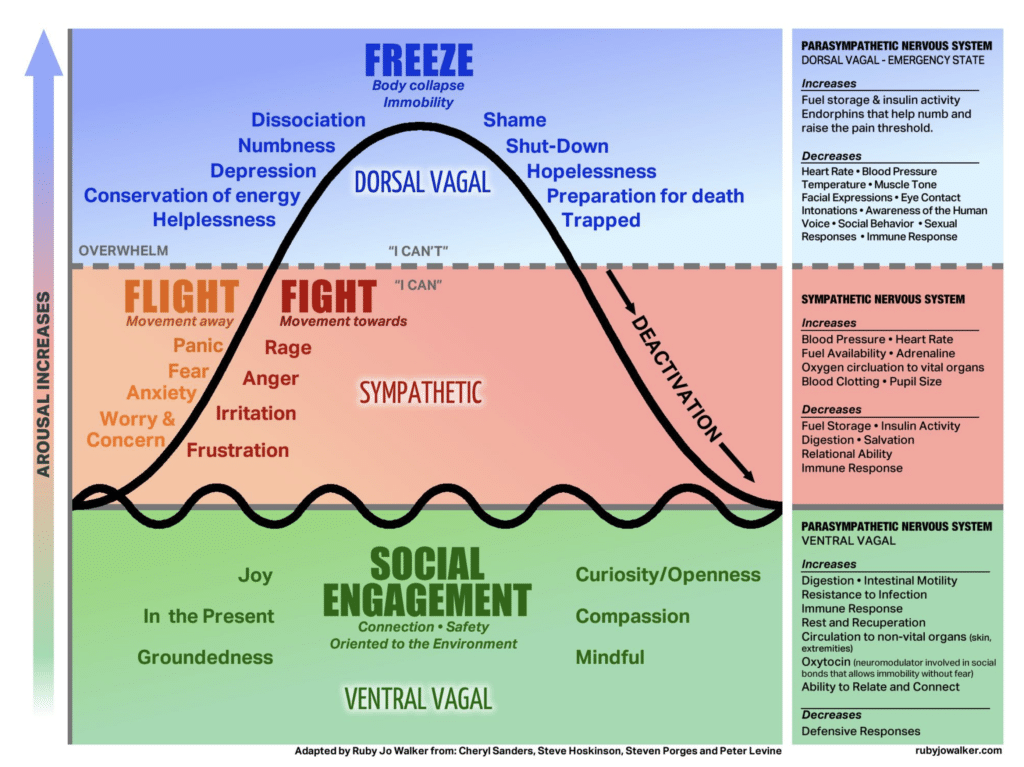When individuals face the profound challenges of grief and trauma, their emotional and physiological responses can be overwhelming. Within this context, understanding the concept of the “Window of Tolerance” becomes crucial. This concept, rooted in nervous system regulation, offers valuable insights into how we process and cope with these emotionally charged experiences. In this post, we will explore the Window of Tolerance, its significance in grief and trauma, and strategies for staying within this adaptive zone.
➡️ Also, check out the following articles for more information:
The Window of Tolerance: An Overview
The Window of Tolerance, a concept developed by Dr. Dan Siegel and further expanded upon by Dr. Pat Ogden and other experts in the field of trauma therapy, describes a range of emotional arousal in which an individual can effectively manage stressors, emotions, and thoughts. Think of it as a zone within which you can navigate life’s ups and downs without becoming overwhelmed or dissociating.
Expanding the Window of Tolerance: Understanding that the Window of Tolerance is not fixed and can be widened over time through therapeutic interventions is empowering. This expansion equips individuals to confront the challenges of grief and trauma while maintaining emotional regulation.
The Role of the Window of Tolerance in Grief
The Window of Tolerance can help individuals make sense of the natural emotions following a loss and navigate the grieving process more effectively.
Recognizing Emotional Dysregulation: Grief can push individuals to the edges of their Window of Tolerance, causing emotional dysregulation. Recognizing this state is the first step in finding strategies to manage it.
Staying Present with Grief: Staying within the Window of Tolerance allows individuals to remain present with their grief without becoming overwhelmed. This presence enables them to process their emotions, which is crucial for healing.
➡️ Listen to the Podcast episode on Trauma and Its Impact on the Nervous System.
The Window of Tolerance in Trauma Recovery
Trauma, whether from a single event or ongoing experiences, can significantly impact an individual’s nervous system. Understanding the Window of Tolerance is essential in trauma recovery.
Hyperarousal and Hypoarousal: Trauma can lead to periods of hyperarousal (intense anxiety, agitation) or hypoarousal (numbness, dissociation). Both states can push individuals outside their Window of Tolerance, making it difficult to process the trauma.
Regulating the Nervous System: Trauma-focused therapies, such as Eye Movement Desensitization and Reprocessing (EMDR) and Somatic Experiencing, aim to regulate the nervous system by helping individuals return to their Window of Tolerance. These approaches empower survivors to process their traumatic memories more effectively.
Staying Within the Window of Tolerance: Strategies
- Mindfulness and Meditation: Mindfulness practices, which encourage non-judgmental awareness of thoughts and emotions, can help individuals stay within their Window of Tolerance. Meditation and deep breathing exercises promote relaxation and self-regulation, making them valuable tools in grief and trauma recovery.
- Self-Compassion: Practicing self-compassion is essential. Acknowledge that grief and trauma are natural human experiences, and it’s okay to seek help when needed. Self-blame and judgment can push you outside your Window of Tolerance.
- Therapeutic Support: Seeking professional help, especially from therapists trained in trauma-informed care, can be transformative. Therapists employ various techniques to guide individuals back into their Window of Tolerance, helping them process their emotions and experiences.
- Grounding Techniques: Grounding exercises, such as focusing on your senses or using objects to anchor yourself in the present moment, can be immensely helpful in moments of distress. These techniques prevent emotional dysregulation and help maintain stability.
Example: Box Breathing
Personally, Box Breathing is one of my favorites and it is an excellent way to stay within the Window of Tolerance. Box Breathing, also known as square breathing or four-square breathing, is a simple yet effective technique for regulating the nervous system and managing stress or overwhelming emotions.
Here’s how it works:
- Find a Quiet Space: Start by finding a quiet and comfortable place to sit or stand. It’s helpful to close your eyes to minimize distractions.
- Set a Breath Count: Imagine drawing a square in your mind or visualize a box. You will inhale, hold, exhale, and then hold again, each for an equal count. A count of four is a common starting point, but you can adjust it based on your comfort level.
- Inhale (4 Counts): Begin by taking a slow, deep breath in through your nose, counting to four as you inhale. Feel your chest and abdomen expand as you fill your lungs with air.
- Hold (4 Counts): After the inhale, hold your breath for the same count of four. Keep your lungs full, but don’t strain.
- Exhale (4 Counts): Slowly exhale through your mouth, counting to four as you release the air. Focus on emptying your lungs completely.
- Hold (4 Counts): Once your lungs are empty, hold your breath again for the count of four before beginning the cycle again.
Repeat this Box Breathing pattern for several rounds, ideally for a few minutes. As you continue, you’ll likely notice a sense of calm and relaxation as your nervous system becomes regulated. Box Breathing is particularly effective because it balances the sympathetic (fight or flight) and parasympathetic (rest and digest) nervous systems, helping you stay within your window of tolerance.
It’s a portable technique that you can use anywhere, making it a valuable tool for managing stress, anxiety, and emotions, especially in the context of grief and trauma.
The Take Away
In the realm of grief and trauma, the Window of Tolerance is a critical concept in understanding how our nervous system responds to stress and emotional upheaval. It serves as a guide, helping individuals recognize when they are approaching their limits and need to employ strategies for regulation. By staying within their Window of Tolerance, individuals can navigate the challenging terrain of grief and trauma with greater resilience, ultimately moving toward healing and recovery. Remember that this journey is unique for each person, and seeking professional guidance can provide valuable support along the way.

